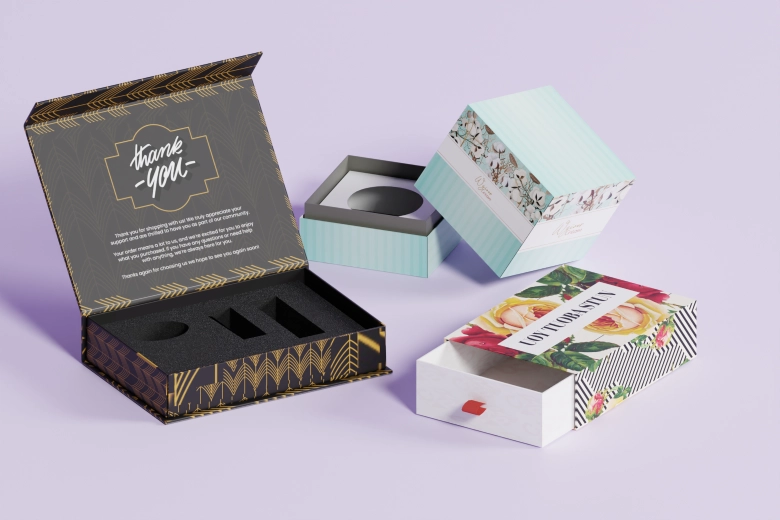Rigid stock proves to be a preferable option for businesses that require sturdy packaging materials to protect their products. In addition to being sturdy and rigid, stock comes with a high-end, smooth surface, making it ideal for manufacturing custom boxes for luxury products. If you aim to provide optimal protection for your products while maintaining an elegant appearance, rigid stock is the perfect choice. But why rigid stock? What makes it a favorite packaging material for many businesses? How is a rigid box made? Read the complete guide below!
What Is Rigid Stock?
In brief, rigid stock is a combination of card and paper stock that provides significant protection and structural integrity. The material is often made by compressing layers of cardboard and then wrapping it with paper stock for printing.
Rigid stock offers high durability and a smooth texture, making it the ideal choice for ensuring product safety and quality. Furthermore, the material is suitable for printing vibrant packaging designs.
What Are the Types of Rigid Stock?
Rigid stock comes in three main types, allowing you to choose the one that best suits your packaging needs.
What are they?
- Gray Chipboard: This is the most common type, made from recycled paper, offering moderate strength and rigidity.
- Duplex Chipboard: Laminated with a white-coated surface, this type offers a smooth, printable surface.
- Kraft Chipboard: Made from unbleached kraft pulp, comes in a natural brown color.
What Is a Rigid Box?
Rigid boxes, also known as set-up boxes, are custom boxes made using rigid stock. As you might have figured out, the high durability of rigid stock ensures the high quality of the boxes. Moreover, the boxes come with an unbending property, ensuring that the products inside remain safe during transit and shipping. Additionally, the smooth texture of rigid stock makes it a preferred choice for brands that want to provide optimal product protection while presenting their products in the best possible light.
How Is a Rigid Box Made?
Indeed, producing rigid box packaging requires time and attention to detail.
Here are the steps for making this trendy box.
Step 1: Choose the Material You Like
Whether you choose Gray, Duplex, or Kraft Chipboard, rest assured that each material offers excellent resistance to various external factors.
Step 2: Sizing
Measure your product’s size and dimensions to know the accurate size your box should be.
Step 3: Folding
The next step is folding, which is transforming the flat sheets into the skeleton of your box. To prevent product damage and make your box look professionally produced, ensure that each fold is precise.
Step 4: Printing
The printing stage is essential for enhancing brand recognition and effectively highlighting your product displays. You can choose from digital or offset printing techniques to make your custom rigid boxes look vibrant and stylish. Even better, you can print your brand’s logo and product details to deliver a strong business image.
Step 5: Wrapping
Wrapping is the final stage of producing your rigid box. Here, your box will be covered by a printed layer, which can be matte or shiny, depending on your preference. Wrapping the box ensures excellent safety during transit while delivering a luxurious look.
Why Businesses Choose Custom Rigid Boxes?
No doubt, many businesses across industries choose custom rigid boxes for more than one good reason. In fact, when designed carefully, these boxes offer tremendous benefits that no business can afford to ignore.
Superior Product Protection
Rigid stock ensures that every custom box is of premium quality, providing superior protection for the product. Whether you’re packing lightweight items like jewelry or shipping fragile glassware, rigid boxes guarantee its safety.
Improved Brand Perception
A rigid box can improve a brand perception, even if you’re a new business. The sturdiness, luxurious appeal, and memorable unboxing created by a sturdy, smooth, rigid stock can increase the product’s perceived value. Ultimately, when customers perceive your product as high-end, they will surely perceive your brand as a reliable one.
A Powerful Marketing Tool
The term ‘custom’ in custom rigid boxes means that the boxes can be tailored to your specific business needs and expectations. Every aspect of the box, from size and shape to design and printing, can be customized to suit your needs. Ultimately, every box you have will serve as a powerful marketing tool that promotes your business.
The Popular Types of Rigid Boxes
Every brand wants its products to look unique and elegant. Fortunately, there are different types of rigid boxes to choose from.
Here are the most popular ones!
- Magnetic Closure Boxes: Rigid boxes with magnetic flaps that securely close the lid, making every unboxing moment memorable.
- Telescopic Boxes: The boxes come in two pieces, with the lid covering the base partially or fully.
- Custom Book Boxes: Featuring a hinged lid that opens like a book, these boxes provide a secure fit for high-end products.
- Two-Piece Boxes: These are the most preferred types of rigid boxes, consisting of two pieces: a base and a detachable lid.
- Drawer Boxes: The boxes that consist of a rigid sleeve with a closed end and a sliding drawer.
- Collapsible Boxes: The boxes can be folded flat for easy storage and assembled into a rigid structure.
- Shoulder Neck Boxes: Unique rigid boxes that feature a lift-off lid and a raised neck tray inside.
Need a custom style for your rigid box? You can get it by working with an experienced manufacturer, such as Custom Rigid Boxes.
How to Choose the Right Rigid Boxes?
Getting the right custom boxes is compulsory for product safety and display. However, with the various attractive style options, choosing the right rigid boxes can be challenging.
Here are practical tips to help you choose the right one:
- Assess your product’s needs regarding size, weight, and fragility
- Consider the brand’s image and desired unboxing experience
- Pay attention to the functionality, material choices, and production capacity you need
Summing Up
Indeed, rigid stock proves to be a preferable option for businesses that require sturdy packaging materials to protect their products. In addition to being sturdy, rigid stock comes with a high-end, smooth surface, ideal for manufacturing custom rigid boxes for luxury products. The high durability of rigid stock ensures the high quality of the boxes. Additionally, the smooth texture of rigid stock makes it a preferred choice for brands that want to provide optimal product protection while presenting their products in the best possible light.
Undoubtedly, getting the right rigid boxes is compulsory for product safety and display. Hopefully, the complete guide we’ve revealed above helps you gain a better understanding of rigid stock and everything your business should know.
FAQs
What is rigid stock?
Rigid stock is a combination of card and paper stock that provides significant protection and structural integrity. The material is often made by compressing layers of cardboard and then wrapping it with paper stock for printing.
How many types of rigid stock are available?
There are three main types of rigid stock, including Gray Chipboard, Duplex Chipboard, and Kraft Chipboard.
What are rigid boxes?
Rigid boxes, also known as set-up boxes, are custom boxes made using rigid stock. As you might have figured out, the high durability of rigid stock ensures the high quality of the boxes.
Why do many businesses choose rigid boxes?
Businesses across various industries choose rigid boxes because they offer benefits such as superior product protection, improved brand perception, and serve as a powerful marketing tool.



